Target your inventory with roadblocking
Roadblocks allow you to serve multiple creatives together on the same page. Roadblocks are only available on managed inventory, where you can control the settings on both the buy side and the sell side.
About roadblocking
Roadblocking is only available when the following criteria are met:
- You are buying direct inventory.
- Booked revenue is set to CPM or vCPM.
- Roadblocking can be set on either the line item or the campaign, not both.
Important things to note about roadblocking campaigns and tag setup include:
- Microsoft Advertising will always attempt to "fill up" a tag with roadblocking campaigns, but each placement will become a separate auction if that's not possible.
- It is the publisher's responsibility to correctly place code snippets on the page for all components of the tag.
- In the auction, there are as many auctions (and as many associated auction fees) as there are components in the tag. For example, if the tag contains four components, every time the page loads there will be four auctions, four impressions shown, etc. Note that if the publisher only places code snippets on the page in two places for a tag with four total components, there will still be four auctions, four impressions, and so on. The ad server has no way of knowing that the last two code snippets weren't placed correctly.
Roadblock categories
There are two categories of roadblock: creative level and page level.
Creative level
Creative-level roadblocks can be set on either the line item or the campaign (not both). Each impression is treated separately from the standpoint of impression budget and frequency capping. For example, suppose you have a budget of 100 impressions and a frequency cap of five impressions per day. You set up a Creative-level roadblock that serves three creatives to the page. The remaining budget for that roadblock would be 97 impressions, and the remaining frequency cap for that user would be two impressions for the rest of that day.
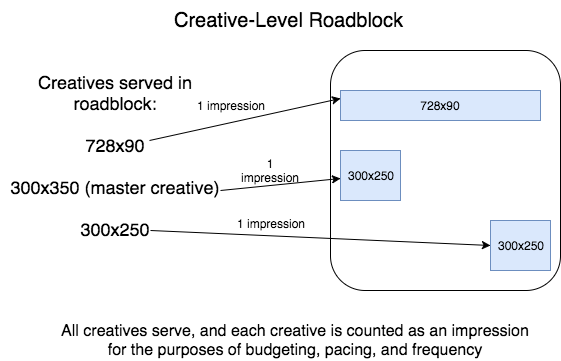
Page level
Page-level roadblocks can be set only on the line item. For a page-level roadblock line item, a single impression is counted when the roadblock serves, no matter how many creatives are delivered to the page. For example, suppose you have a budget of 100 impressions and a frequency cap of five impressions per day. You set up a page-level roadblock that serves three creatives to the page. The remaining budget for that roadblock would be 99 impressions, and the remaining frequency cap for that user would be four impressions for the rest of that day.
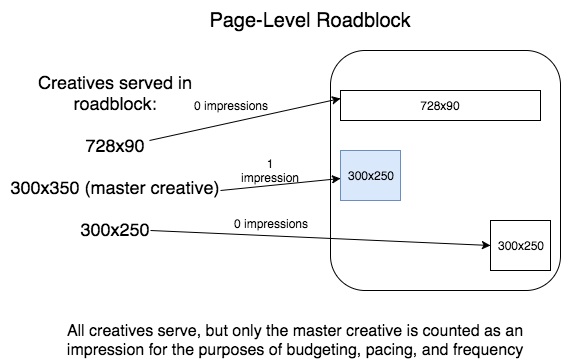
Master creative determination
When setting up a page-level roadblock, you will declare a master size. For the line item to participate in the auction, at least one of its creatives matching the master size must be eligible. If the master creative serves, then one impression is counted for the line item.
It’s possible that you could have more than one eligible creative matching the specified master size. You could also have multiple tags in the ad request that match that size. In either of these cases, the creative that will be designated as the master is the one that serves to the highest tag in the ad call that matches the master size.
vCPM guarantees
If a vCPM guaranteed line item (which budgets against views, not impressions) is set up as a page-level roadblock, then the view count of the master creative will be used for budgeting, pacing, and frequency caps. For example, suppose you have a budget of 100 views and a frequency cap of five views per day. You set up a page-level vCPM guaranteed roadblock that serves three creatives to the page, two of which are measured as viewed (including the master creative). The remaining budget for the roadblock would be 99 views, and the remaining frequency cap for that user would be four views for the rest of that day.
Roadblock types
There are three types of roadblock: normal, partial, and exact. For the following examples, the line item or campaign has the following creatives:
- 729 x 90
- 300 x 250
- 300 x 250
- 180 x 150
- 468 x 60
The diagrams below show the available impressions and whether a roadblock of the given type would serve with these creatives.
Normal
For a normal roadblock to serve, the number of creatives must be greater than or equal to the number of ad slots.
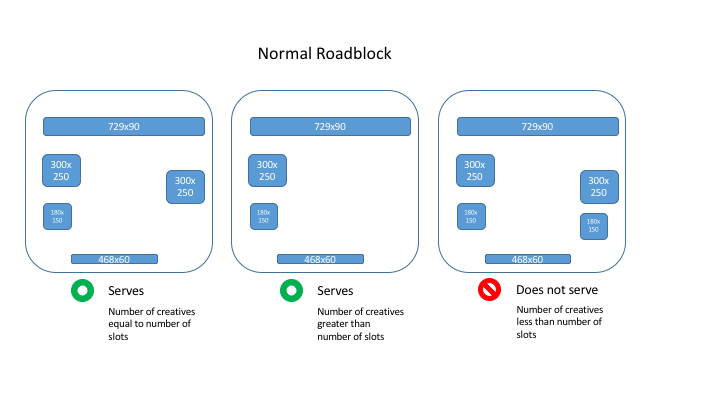
Partial
To serve a partial roadblock, one creative for each size must be eligible to serve on the page.
All creatives will serve if ad slots are available. If more than one creative per size exists, creative will rotate through a single slot. There can be more ad slots available than there are creatives to fill them.
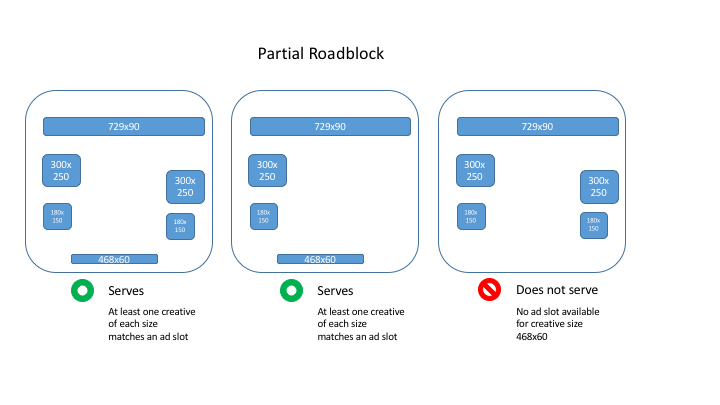
Exact
To serve an exact roadblock, the number of creatives must be exactly equal to the number of ad slots.
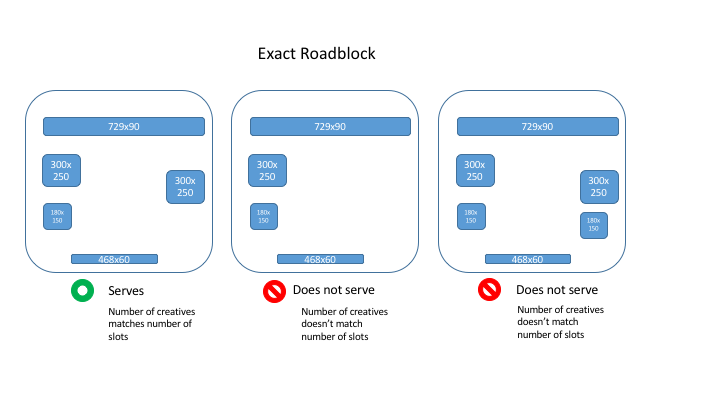
Setting up roadblocks
Since multi-tag requests are required for roadblocking, you will need to set up Microsoft Advertising's seller tag (AST) on your publisher's inventory.
In order to run roadblock campaigns, you need to target the tag(s) you just created. For instructions on targeting a specific placement, see the Target specific slices of direct inventory section of Create a Campaign. Then, enable roadblocking as follows:
- For campaign-level roadblocking, follow the instructions in the Enable Roadblocking section of Create a Campaign.
- For line item-level roadblocking, follow the instructions in Create a Standard Line Item.
- If you are a publisher client with access to Guaranteed Delivery, turn on roadblocking when you Create a Guaranteed Delivery Line Item.